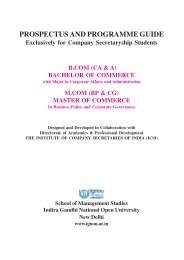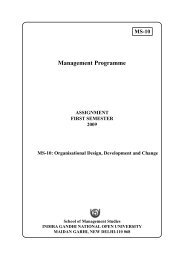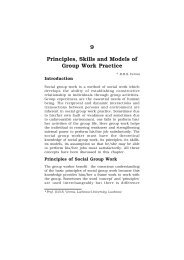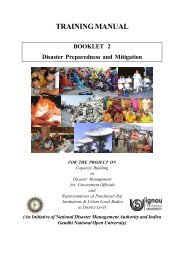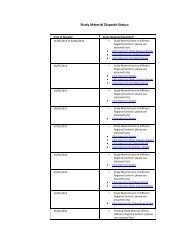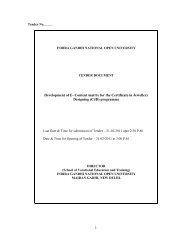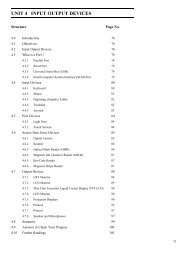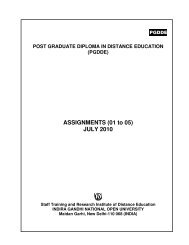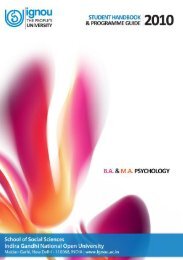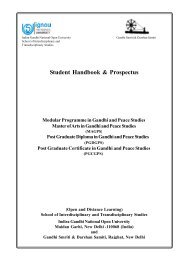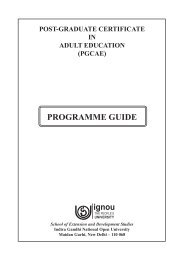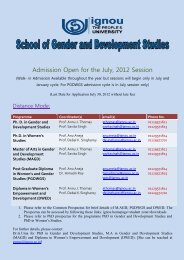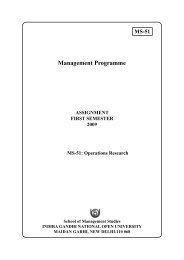Jan-July-2010 - IGNOU
Jan-July-2010 - IGNOU
Jan-July-2010 - IGNOU
You also want an ePaper? Increase the reach of your titles
YUMPU automatically turns print PDFs into web optimized ePapers that Google loves.
CFN<br />
Certificate Programme in Food and Nutrition<br />
ASSIGNMENTS 1 TO 3<br />
<strong>Jan</strong>uary <strong>2010</strong> and <strong>July</strong> <strong>2010</strong><br />
School of Continuing Education<br />
Indira Gandhi National Open University<br />
Maidan Garhi, New Delhi -110068<br />
1
Certificate Programme in Food and Nutrition (CFN)<br />
ASSIGNMENTS 1-3<br />
<strong>2010</strong><br />
Dear Students,<br />
You will have to do three assignments in all. All the assignments are tutor marked. Each Tutor Marked<br />
Assignment (TMA) carries 100 marks. The course-wise distribution of assignments is as follows:<br />
Assignment 1 (TMA) - based on CFN-1<br />
Assignment 2 (TMA) - based on CFN-2<br />
Assignment 3 (TMA) - based on CFN-3<br />
INSTRUCTIONS<br />
Before attempting the assignments please read the following instructions carefully.<br />
1) Read the detailed instructions about assignments given in the Programme Guide.<br />
2) Write your roll number, name, full address and date on the top right corner of the<br />
first page of your response sheet(s).<br />
3) Write the course title, assignment number and name of the study centre you are<br />
attached to in the centre of the first page of your response sheet(s).<br />
The top of the first page of your response sheet should look like this:<br />
Enrolment No…………………….<br />
Name……………………………..<br />
Address…………………………..<br />
…………………………..<br />
Course Title………………………<br />
Assignment No………………….. Date …………………………<br />
Study Centre……………………..<br />
4) Use only foolscape size paper for your responses and tie all the pages carefully.<br />
5) Write the question number with each answer.<br />
6) You should write in your own handwriting.<br />
7) Submission: The completed Assignment should be sent to the Coordinator of the Study Centre<br />
allotted to you.<br />
2
A Note of Caution<br />
It has been noticed that some students are sending answers to Check Your Progress Exercises to the<br />
University for evaluation. Please do not send them to us. These exercises are given to help in judging your<br />
own progress. For this purpose, we have provided the answers to these exercises at the end of each Unit.<br />
We have already mentioned this in the Programme Guide.<br />
Before despatching your answer script, please make sure you have taken care of the following points:<br />
<br />
<br />
<br />
<br />
Your roll number, name and address have been written correctly.<br />
The title of the course and assignment number have been written clearly.<br />
Each assignment on each course has been written on separate sheets and pinned properly.<br />
All the questions in the assignments have been answered.<br />
Now read the guidelines before answering questions.<br />
GUIDELINES FOR TMA<br />
The Tutor Marked Assignments have two parts.<br />
Section A: Descriptive and Short Answer Questions<br />
Section B: Practical Exercises<br />
(60 marks)<br />
(40 marks)<br />
POINTS TO KEEP IN MIND<br />
You will find it useful to keep the following points in mind:<br />
1) Planning: Read the assignments carefully. Go through the units on which they are based. Make<br />
some points regarding each question and then rearrange these in a logical order.<br />
2) Organization: Be a little more selective and analytical. Give attention to your introduction and<br />
conclusion. The introduction must offer your brief interpretation of the question and how you<br />
propose to develop it. The conclusion must summarize your response to the question.<br />
Make sure that your answer:<br />
a) is logical and coherent;<br />
b) has clear connections between sentences and paragraphs;<br />
c) is written correctly giving adequate consideration to your expression, style and<br />
presentation;<br />
d) does not exceed the number of words indicated in the question.<br />
3) Presentation: Once you are satisfied with your answers, you can write down the final version for<br />
submission, writing each answer neatly and underline the points you wish to emphasize.<br />
3
ASSIGNMENT 1<br />
(TMA-1)<br />
Course Code:CFN-1<br />
Assignment Code: CFN-1/AST-1/TMA-1/10<br />
For <strong>Jan</strong>uary <strong>2010</strong> session Last date for submission: 15 March, <strong>2010</strong><br />
For <strong>July</strong> <strong>2010</strong> session Last date for submission: 15 September, <strong>2010</strong><br />
Maximum marks :100<br />
Assignment-1 consists of two parts and is of 100 marks. The weightage given to each part is<br />
indicated in the brackets.<br />
a) Descriptive Type Questions (60 marks)<br />
b) Practical Exercises (40 marks)<br />
Part A: Descriptive Type Questions (60 marks)<br />
1. Write short notes on the following: (20)<br />
i) Physiological functions of food.<br />
ii) Sources, functions and the effects of deficiency of Vitamin D.<br />
iii) Effects of different processing methods on the quality of food.<br />
iv) Nutritive value of cereals.<br />
2. Briefly discuss the uses of sugar in different food preparations depending on their<br />
properties. (5)<br />
3. What points would you keep in mind while selecting/purchasing the following: (15)<br />
(i)<br />
(ii)<br />
(iii)<br />
Spices<br />
Fruits<br />
Oilseeds<br />
4. What factors influence our acceptance of food. Discuss briefly. (5)<br />
5. Discuss the functions and food sources of the macronutrients needed by our body. (15)<br />
4
Part B: Practical Exercises (40 marks)<br />
This part consists of two practical exercises. You have to attempt both.<br />
1. Conduct a survey in your nearby market and find out the different foods preserved by<br />
sugar, salt, acid, oil and chemical preservatives. (10)<br />
2. State which types of sugar should be used in the preparation of the following dishes:<br />
(a) Sqashes<br />
(b) Cakes<br />
(c) Kheer<br />
(d) Groundnut Chikki<br />
(e) Biscuits<br />
3.(a) Explain with examples the role of the following nutrients in regulating our body processes<br />
and body protection. (5)<br />
i) Proteins ii) Water<br />
(b) Cut the seasonal vegetables available in your market into different sizes (small, medium,<br />
large) cook them by the following methods (5)<br />
(i) Boiling<br />
(ii) Blanching<br />
(iii) Drying<br />
Record your observations in terms of time of cooking, appearance and texture. Which<br />
method of cooking leads to greater loss of nutrients.<br />
4. Suggest any two food preparations made from the following milk products (10)<br />
i) Khoa ii) Paneer iii) Ghee iv) Cream<br />
Guideline: List down the ingredients and the method of preparation.<br />
5. Comment on any<br />
Difference in cooking time, texture and appearance of idli which has been prepared using<br />
(a) fermented bolter and (b) unfermented bolter. (5)<br />
5
Assignment 2 consists of two parts<br />
ASSIGNMENT -2<br />
(TMA-2)<br />
Course Code: CFN-2<br />
Assignment Code: CFN-2/AST-2/TMA-2/10<br />
For <strong>Jan</strong>uary <strong>2010</strong> session last Date for Submission: 31 March, <strong>2010</strong><br />
For <strong>July</strong> <strong>2010</strong> session last date for submission: 30 September, <strong>2010</strong><br />
a) Descriptive Type Questions (DTQ) (60 marks)<br />
b) Practical Exercises (PE) (40 marks)<br />
Part A: DTQ (Descriptive Type Question)<br />
Maximum Marks: 100<br />
(60 marks)<br />
There are four questions in this part. The answers to these questions should be brief and precise.<br />
1. Describe the relationship between growth spurt and nutritional requirements during<br />
adolescence. (5)<br />
2. Explain how the energy varies with age and the kind of physical work? (5)<br />
3. Explain the process of digestion, absorption and utilization of nutrients in the body. Support<br />
your answer with diagrams (10)<br />
4. What is PEM? Explain the causes and characteristic features of different forms of PEM. (8)<br />
5. What is the difference between overweight and obesity? (2)<br />
6. What specific considerations would you keep in mind while planning diets for (5+5+5)<br />
(i)<br />
(ii)<br />
(iii)<br />
Pregnant woman<br />
Preschooler<br />
Adolescent<br />
Hint: You can discuss it with reference to nutritional needs, physiological changes, if any,<br />
special needs, food preparations, meal frequency, pattern etc.<br />
7. Why is growth monitoring of children important? How would you monitor growth of<br />
children? (5)<br />
8. Briefly discuss the critical periods of growth? (5)<br />
9. How can you minimize nutrients losses in food processing? (5)<br />
6
Part B: PE (Practical Exercises)<br />
There are two exercises in this part. You have to attempt all questions.<br />
(40 marks)<br />
1. Indicate the activity group to which the following people belong. (5)<br />
(i)<br />
(ii)<br />
(iii)<br />
(iv)<br />
School Teacher<br />
Typist<br />
Housewife<br />
Coolie<br />
(v) Farmer<br />
2. Record the weight of ten four year old children in your locality. Determine their growth status<br />
using the weight chart. Record your observations in a tabulated form. (10)<br />
3.(a) Suggest a meal for Vibha, who is in her second half of pregnancy. List the points you<br />
would keep in mind while planning a diet for the pregnant woman (10)<br />
(b) Plan two dishes that can be given to Schoolage children for their lunch. (10)<br />
(Give the ingredients and method of preparation also.)<br />
(c) What do you think is the right age to introduce solid foods to infants. Give reasons for<br />
your answer. What advice would you give to Ritu who is planning to give solid food to her<br />
six month old daughter. (5)<br />
7
ASSIGNMENT -3<br />
(TMA-3)<br />
Course Code: CFN-3<br />
Assignment Code: CFN-3/AST-3/TMA-3/10<br />
For <strong>Jan</strong>uary <strong>2010</strong> session last Date for Submission: 31 March, <strong>2010</strong><br />
For <strong>July</strong> <strong>2010</strong> session last Date for Submission: 15 October, <strong>2010</strong><br />
Maximum Marks: 100<br />
Assignment 3 consists of two parts:<br />
a) Descriptive Type Questions (DTQ) (60 marks)<br />
b) Practical Exercises (PE) (40 marks)<br />
Part A: DTQ (Descriptive Type Questions)<br />
(60 Marks)<br />
Section A<br />
1. a) Describe the factors influencing food expenditure. (5)<br />
b) What factors you need to keep in mind while preparing a food budget. (5)<br />
2. What are the different components of food subsidy? Explain each in brief. (10)<br />
3. What are the different agencies providing consumer education? Discuss briefly. (10)<br />
4. Briefly describe the different forms of subsidies given to the agriculture sector. (6)<br />
5. How have the following enterprises contributed to the farmers income. (8)<br />
o Paultry<br />
o Pisciculture<br />
6. What are the objectives and achievements of operation flood- phase-I and phase-II. (10)<br />
7. List the different feeding programmes. Explain any two. (6)<br />
8
Part B: Practical Exercise<br />
(40 marks)<br />
Section B<br />
1.Prepare a food budget of your family for a period of four months. (10)<br />
2. Visit a Fair Price Shop functioning under Public Distribution System in our around your<br />
locality/area. Identify the food items and the cost of these items being sold at the fair price<br />
shop. Also identify the beneficiaries. (10)<br />
3. Visit the office of the Department of Agriculture of the town you live in and list down the<br />
training programmes it arranged for farmers during 2007-2008 (10)<br />
4. Visit an anganwadi centre functioning under ICDS programme in your town. Prepare a list of<br />
services provided, the different beneficiaries and the mid-day meal provided at the center. (10)<br />
9



